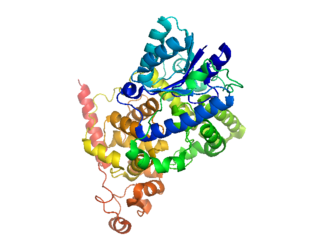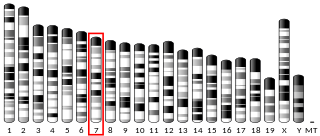Related Research Articles

The suprachiasmatic nucleus or nuclei (SCN) is a small region of the brain in the hypothalamus, situated directly above the optic chiasm. The SCN is the principal circadian pacemaker in mammals, responsible for generating circadian rhythms. Reception of light inputs from photosensitive retinal ganglion cells allow the SCN to coordinate the subordinate cellular clocks of the body and entrain to the environment. The neuronal and hormonal activities it generates regulate many different body functions in an approximately 24-hour cycle.
A circadian clock, or circadian oscillator, is a biochemical oscillator that cycles with a stable phase and is synchronized with solar time.

Cryptochromes are a class of flavoproteins found in plants and animals that are sensitive to blue light. They are involved in the circadian rhythms and the sensing of magnetic fields in a number of species. The name cryptochrome was proposed as a portmanteau combining the chromatic nature of the photoreceptor, and the cryptogamic organisms on which many blue-light studies were carried out.
The Casein kinase 1 family of protein kinases are serine/threonine-selective enzymes that function as regulators of signal transduction pathways in most eukaryotic cell types. CK1 isoforms are involved in Wnt signaling, circadian rhythms, nucleo-cytoplasmic shuttling of transcription factors, DNA repair, and DNA transcription.

CLOCK is a gene encoding a basic helix-loop-helix-PAS transcription factor that is known to affect both the persistence and period of circadian rhythms.
Timeless (tim) is a gene in multiple species but is most notable for its role in Drosophila for encoding TIM, an essential protein that regulates circadian rhythm. Timeless mRNA and protein oscillate rhythmically with time as part of a transcription-translation negative feedback loop involving the period (per) gene and its protein.
Period (per) is a gene located on the X chromosome of Drosophila melanogaster. Oscillations in levels of both per transcript and its corresponding protein PER have a period of approximately 24 hours and together play a central role in the molecular mechanism of the Drosophila biological clock driving circadian rhythms in eclosion and locomotor activity. Mutations in the per gene can shorten (perS), lengthen (perL), and even abolish (per0) the period of the circadian rhythm.

Neuronal PAS domain protein 2 (NPAS2) also known as member of PAS protein 4 (MOP4) is a transcription factor protein that in humans is encoded by the NPAS2 gene. NPAS2 is paralogous to CLOCK, and both are key proteins involved in the maintenance of circadian rhythms in mammals. In the brain, NPAS2 functions as a generator and maintainer of mammalian circadian rhythms. More specifically, NPAS2 is an activator of transcription and translation of core clock and clock-controlled genes through its role in a negative feedback loop in the suprachiasmatic nucleus (SCN), the brain region responsible for the control of circadian rhythms.

PER2 is a protein in mammals encoded by the PER2 gene. PER2 is noted for its major role in circadian rhythms.

FBXL3 is a gene in humans and mice that encodes the F-box/LRR-repeat protein 3 (FBXL3). FBXL3 is a member of the F-box protein family, which constitutes one of the four subunits in the SCF ubiquitin ligase complex.

Aryl hydrocarbon receptor nuclear translocator-like 2, also known as Arntl2, Mop9, Bmal2, or Clif, is a gene.
An Error has occurred retrieving Wikidata item for infobox Period circadian protein homolog 1 is a protein in humans that is encoded by the PER1 gene.

Basic helix-loop-helix ARNT-like protein 1 or aryl hydrocarbon receptor nuclear translocator-like protein 1 (ARNTL), or brain and muscle ARNT-like 1 is a protein that in humans is encoded by the BMAL1 gene on chromosome 11, region p15.3. It's also known as MOP3, and, less commonly, bHLHe5, BMAL, BMAL1C, JAP3, PASD3, and TIC.
In molecular biology, an oscillating gene is a gene that is expressed in a rhythmic pattern or in periodic cycles. Oscillating genes are usually circadian and can be identified by periodic changes in the state of an organism. Circadian rhythms, controlled by oscillating genes, have a period of approximately 24 hours. For example, plant leaves opening and closing at different times of the day or the sleep-wake schedule of animals can all include circadian rhythms. Other periods are also possible, such as 29.5 days resulting from circalunar rhythms or 12.4 hours resulting from circatidal rhythms. Oscillating genes include both core clock component genes and output genes. A core clock component gene is a gene necessary for to the pacemaker. However, an output oscillating gene, such as the AVP gene, is rhythmic but not necessary to the pacemaker.
Steven M. Reppert is an American neuroscientist known for his contributions to the fields of chronobiology and neuroethology. His research has focused primarily on the physiological, cellular, and molecular basis of circadian rhythms in mammals and more recently on the navigational mechanisms of migratory monarch butterflies. He was the Higgins Family Professor of Neuroscience at the University of Massachusetts Medical School from 2001 to 2017, and from 2001 to 2013 was the founding chair of the Department of Neurobiology. Reppert stepped down as chair in 2014. He is currently distinguished professor emeritus of neurobiology.

Cycle (cyc) is a gene in Drosophila melanogaster that encodes the CYCLE protein (CYC). The Cycle gene (cyc) is expressed in a variety of cell types in a circadian manner. It is involved in controlling both the sleep-wake cycle and circadian regulation of gene expression by promoting transcription in a negative feedback mechanism. The cyc gene is located on the left arm of chromosome 3 and codes for a transcription factor containing a basic helix-loop-helix (bHLH) domain and a PAS domain. The 2.17 kb cyc gene is divided into 5 coding exons totaling 1,625 base pairs which code for 413 aminos acid residues. Currently 19 alleles are known for cyc. Orthologs performing the same function in other species include ARNTL and ARNTL2.

Michael Morris Rosbash is an American geneticist and chronobiologist. Rosbash is a professor and researcher at Brandeis University and investigator at the Howard Hughes Medical Institute. Rosbash's research group cloned the Drosophila period gene in 1984 and proposed the Transcription Translation Negative Feedback Loop for circadian clocks in 1990. In 1998, they discovered the cycle gene, clock gene, and cryptochrome photoreceptor in Drosophila through the use of forward genetics, by first identifying the phenotype of a mutant and then determining the genetics behind the mutation. Rosbash was elected to the National Academy of Sciences in 2003. Along with Michael W. Young and Jeffrey C. Hall, he was awarded the 2017 Nobel Prize in Physiology or Medicine "for their discoveries of molecular mechanisms controlling the circadian rhythm".
Hitoshi Okamura is a Japanese scientist who specializes in chronobiology. He is currently a professor of Systems Biology at Kyoto University Graduate School of Pharmaceutical Sciences and the Research Director of the Japan Science Technology Institute, CREST. Okamura's research group cloned mammalian Period genes, visualized clock oscillation at the single cell level in the central clock of the SCN, and proposed a time-signal neuronal pathway to the adrenal gland. He received a Medal of Honor with Purple Ribbon in 2007 for his research and was awarded Aschoff's Ruler for his work on circadian rhythms in rodents. His lab recently revealed the effects of m6A mRNA methylation on the circadian clock, neuronal communications in jet lag, and the role of dysregulated clocks in salt-induced hypertension.
Paul Hardin is an American scientist in the field of chronobiology and a pioneering researcher in the understanding of circadian clocks in flies and mammals. Hardin currently serves as a distinguished professor in the biology department at Texas A&M University. He is best known for his discovery of circadian oscillations in the mRNA of the clock gene Period (per), the importance of the E-Box in per activation, the interlocked feedback loops that control rhythms in activator gene transcription, and the circadian regulation of olfaction in Drosophila melanogaster. Born in a suburb of Chicago, Matteson, Illinois, Hardin currently resides in College Station, Texas, with his wife and three children.
Transcription-translation feedback loop (TTFL) is a cellular model for explaining circadian rhythms in behavior and physiology. Widely conserved across species, the TTFL is auto-regulatory, in which transcription of clock genes is regulated by their own protein products.
References
- 1 2 3 Darlington, Thomas K.; Wager-Smith, Karen; Ceriani, M. Fernanda; Staknis, David; Gekakis, Nicholas; Steeves, Thomas D. L.; Weitz, Charles J.; Takahashi, Joseph S.; Kay, Steve A. (June 1998). "Closing the Circadian Loop: CLOCK-Induced Transcription of Its Own Inhibitors per and tim". Science. 280 (5369): 1599–1603. Bibcode:1998Sci...280.1599D. doi:10.1126/science.280.5369.1599. ISSN 0036-8075. PMID 9616122.
- 1 2 3 4 Aryal, Rajindra P.; Kwak, Pieter Bas; Tamayo, Alfred G.; Gebert, Michael; Chiu, Po-Lin; Walz, Thomas; Weitz, Charles J. (September 2017). "Macromolecular Assemblies of the Mammalian Circadian Clock". Molecular Cell. 67 (5): 770–782.e6. doi:10.1016/j.molcel.2017.07.017. ISSN 1097-2765. PMC 5679067 . PMID 28886335.
- ↑ Weitz, Charles (2023). "Charles Weitz Linkedin". Linkedin. Retrieved 11 April 2023.
- ↑ Weitz, C. J.; Went, L. N.; Nathans, J. (August 1992). "Human tritanopia associated with a third amino acid substitution in the blue-sensitive visual pigment". American Journal of Human Genetics. 51 (2): 444–446. ISSN 0002-9297. PMC 1682686 . PMID 1386496.
- ↑ "FlyTree - Jeremy Nathans". academictree.org. Retrieved 2023-04-26.
- 1 2 "Charles Weitz". neuro.hms.harvard.edu. Retrieved 2023-04-11.
- ↑ "Courses". registrar.fas.harvard.edu. Retrieved 2023-04-26.
- ↑ Gekakis, Nicholas; Staknis, David; Nguyen, Hubert B.; Davis, Fred C.; Wilsbacher, Lisa D.; King, David P.; Takahashi, Joseph S.; Weitz, Charles J. (June 1998). "Role of the CLOCK Protein in the Mammalian Circadian Mechanism". Science. 280 (5369): 1564–1569. Bibcode:1998Sci...280.1564G. doi:10.1126/science.280.5369.1564. ISSN 0036-8075. PMID 9616112.
- ↑ Griffin, Edmund A.; Staknis, David; Weitz, Charles J. (1999-10-22). "Light-Independent Role of CRY1 and CRY2 in the Mammalian Circadian Clock". Science. 286 (5440): 768–771. doi:10.1126/science.286.5440.768. ISSN 0036-8075. PMID 10531061.
- ↑ Cermakian, N. (2001-08-01). "Altered behavioral rhythms and clock gene expression in mice with a targeted mutation in the Period1 gene". The EMBO Journal. 20 (15): 3967–3974. doi:10.1093/emboj/20.15.3967. PMC 149149 . PMID 11483500.
- ↑ Steenhard, Brooke M.; Besharse, Joseph C. (2000-12-01). "Phase Shifting the Retinal Circadian Clock: xPer2 mRNA Induction by Light and Dopamine". The Journal of Neuroscience. 20 (23): 8572–8577. doi:10.1523/JNEUROSCI.20-23-08572.2000. ISSN 0270-6474. PMC 6773079 . PMID 11102460.
- 1 2 Partch, Carrie L.; Green, Carla B.; Takahashi, Joseph S. (February 2014). "Molecular architecture of the mammalian circadian clock". Trends in Cell Biology. 24 (2): 90–99. doi:10.1016/j.tcb.2013.07.002. ISSN 0962-8924. PMC 3946763 . PMID 23916625.
- 1 2 3 4 Padmanabhan, Kiran; Robles, Maria S.; Westerling, Thomas; Weitz, Charles J. (August 2012). "Feedback Regulation of Transcriptional Termination by the Mammalian Circadian Clock PERIOD Complex". Science. 337 (6094): 599–602. Bibcode:2012Sci...337..599P. doi:10.1126/science.1221592. ISSN 0036-8075. PMID 22767893. S2CID 35592602.
- 1 2 Callaway, Ewen (February 2020). "Revolutionary cryo-EM is taking over structural biology". Nature. 578 (7794): 201. Bibcode:2020Natur.578..201C. doi: 10.1038/d41586-020-00341-9 . PMID 32047310. S2CID 256819467.
- ↑ Storch, Kai-Florian; Lipan, Ovidiu; Leykin, Igor; Viswanathan, N.; Davis, Fred C.; Wong, Wing H.; Weitz, Charles J. (May 2002). "Extensive and divergent circadian gene expression in liver and heart". Nature. 417 (6884): 78–83. Bibcode:2002Natur.417...78S. doi:10.1038/nature744. ISSN 1476-4687. PMID 11967526. S2CID 4301811.
- ↑ Lamia, Katja A.; Storch, Kai-Florian; Weitz, Charles J. (September 2008). "Physiological significance of a peripheral tissue circadian clock". Proceedings of the National Academy of Sciences. 105 (39): 15172–15177. doi: 10.1073/pnas.0806717105 . ISSN 0027-8424. PMC 2532700 . PMID 18779586.
- ↑ Duong, H. A.; Robles, M. S.; Knutti, D.; Weitz, C. J. (June 2011). "A Molecular Mechanism for Circadian Clock Negative Feedback". Science. 332 (6036): 1436–1439. Bibcode:2011Sci...332.1436D. doi:10.1126/science.1196766. ISSN 0036-8075. PMC 3859310 . PMID 21680841.
- ↑ Kim, Jin Young; Kwak, Pielter Bas; Weitz, Charles J. (December 2014). "Specificity in Circadian Clock Feedback from Targeted Reconstitution of the NuRD Corepressor". Molecular Cell. 56 (6): 738–748. doi: 10.1016/j.molcel.2014.10.017 . ISSN 1097-2765. PMID 25453762.
- ↑ Aryal, Rajindra P.; Kwak, Pieter Bas; Tamayo, Alfred G.; Gebert, Michael; Chiu, Po-Lin; Walz, Thomas; Weitz, Charles J. (September 2017). "Macromolecular Assemblies of the Mammalian Circadian Clock". Molecular Cell. 67 (5): 770–782.e6. doi:10.1016/j.molcel.2017.07.017. PMC 5679067 . PMID 28886335. S2CID 37629139.
- ↑ "Junior Faculty Grantees – Giovanni Armenise Harvard Foundation" . Retrieved 2023-04-26.